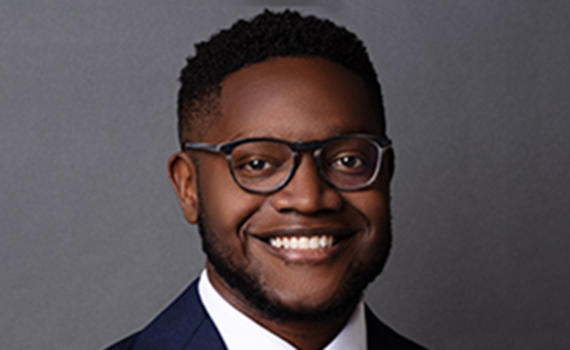By Kiara Harris
 Internal Medicine Resident, Malcolm Chapman, M.D., MBA (PGY-1)
Internal Medicine Resident, Malcolm Chapman, M.D., MBA (PGY-1)
In Black communities, a lack of health literacy — an individual’s ability to obtain, process, and understand basic health information to make appropriate and timely health decisions — can play a critical role in health disparities. The journal Health Literacy Research and Practice reports that physicians overestimate the health literacy scores of 54% of African American patients, compared with 11% of non-Hispanic White and 36% of patients of another race or ethnicity.
Failure to effectively communicate with patients can negatively impact a patient’s health outcomes. First-year internal medicine resident Malcolm Chapman, M.D., MBA, offers his unique insight into issues of representation in medicine and discusses how he works to improve health literacy and close disparity gaps.
Chapman explains that he did not grow up thinking he would become a doctor as he did not see doctors who looked like him. As a result, he believed medicine was not a viable career option for him.
His personal experience demonstrates how the lack of representation in certain environments can lead underrepresented communities to feel disconnected from those environments. With only 5% of practicing physicians identifying as Black in the United States, one could infer disparities in health literacy are associated with a lack of representation among practicing physicians.
Now, as a physician-in-training, Chapman is intentional about closing those gaps by providing exceptional care to underserved communities through attention, communication, and education. “The care I provide for all patients is personal,” he says.
Chapman shares that a combination of ongoing training and personal experience allows him to identify instances that may require further communication. “Witnessing family members go through situations of misunderstanding in the health care system, encourages me to make sure every patient leaves feeling comfortable with the information they are provided.”
“It’s important to me that no patient gets overlooked.” He goes on to say that since he began his training, he notices underserved patients often allow doctors to proceed with appointments without further inquiry into their diagnosis.
A 2020 study found that care for Black patients is improved when they see black physicians. The study randomly assigned 1,300 African American patients to Black or non-Black primary care physicians. Those who saw Black doctors received 34% more preventive services. The study attributes these results to improved trust and communication.
“I think when the patient can identify with you, they have a bit more freedom and comfort to open up, ask questions, and put themselves out there.”
The first strategy Chapman uses to address potential gaps is following up immediately after they receive information. He reapproaches patients with empathy. He might say, “That was a lot of information, do you have any questions about what was said?” He observes that this step often makes patients feel more comfortable about having an additional conversation.
The second strategy is making sure the patient always receives a recap of what was said. During his recap, Chapman uses every-day terms or common metaphors to clarify anything that could have been misinterpreted.
Finally, Chapman incorporates an education component to his conversation. His goal is to help guide them through how to communicate essential information to their caregivers or family members.
Chapman explains that physician-to-patient communication is not the only strategy he uses to improve health literacy. He is a part of UAB’s recruitment effort to bring more trainees from underrepresented backgrounds into the residency program. Through this initiative, he hopes to further champion representation, diversity, and equality.
Chapman says his ultimate goal is to be a part of environments that promote comfortability among patients and physicians. He is optimistic that his desire to lead by example will help those around him to recognize health literacy gaps and understand how and when to address them.
“The thing that drives me most is making sure people feel like something has changed for the better during our interaction, however brief it may be,” Chapman concludes.